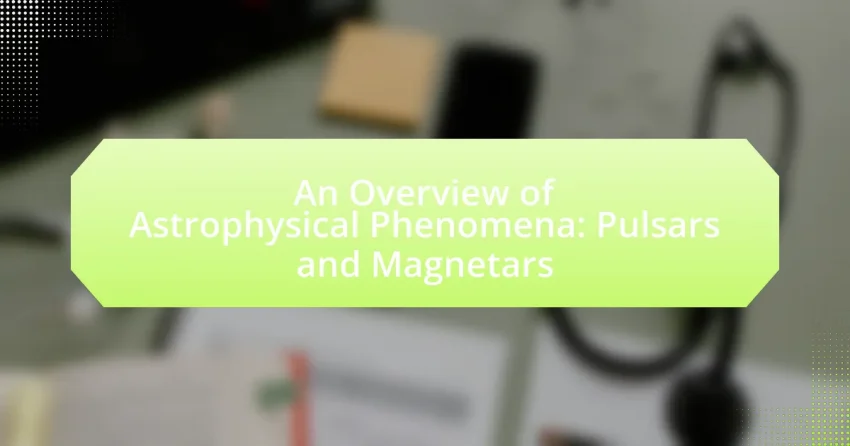Pulsars and magnetars are two distinct types of neutron stars that play significant roles in astrophysics. Pulsars are highly magnetized, rotating neutron stars that emit beams of electromagnetic radiation, primarily observed in radio wavelengths, while magnetars possess extraordinarily strong magnetic fields, leading to intense bursts of X-rays and gamma rays. The article explores their defining characteristics, formation processes, and the differences between them, as well as their importance in understanding extreme physical conditions and fundamental astrophysical processes. Additionally, it discusses the observational techniques used to study these celestial objects and the implications of their research for future advancements in astrophysics.

What are Pulsars and Magnetars?
Pulsars are highly magnetized, rotating neutron stars that emit beams of electromagnetic radiation, typically observed in radio wavelengths. These beams are produced due to the star’s rapid rotation and strong magnetic fields, leading to a lighthouse effect as the beams sweep across the Earth. Magnetars, on the other hand, are a type of neutron star with an extremely powerful magnetic field, over a thousand times stronger than that of typical pulsars. This intense magnetic field can cause significant bursts of X-rays and gamma rays, making magnetars some of the most energetic objects in the universe. The existence of pulsars and magnetars is supported by observational data, including the detection of periodic signals from pulsars and the identification of magnetar outbursts through high-energy astrophysical observations.
How do Pulsars differ from Magnetars?
Pulsars differ from magnetars primarily in their magnetic field strength and emission mechanisms. Pulsars are highly magnetized, rotating neutron stars that emit beams of electromagnetic radiation, typically observed as regular pulses due to their rotation. In contrast, magnetars possess an extremely strong magnetic field, often exceeding 10^14 gauss, which can lead to intense bursts of X-rays and gamma rays, rather than the regular pulsing observed in pulsars. The distinction is further highlighted by their formation; pulsars are formed from the remnants of supernova explosions, while magnetars are a specific type of neutron star that has undergone a different evolutionary path, resulting in their unique magnetic properties.
What are the defining characteristics of Pulsars?
Pulsars are highly magnetized, rotating neutron stars that emit beams of electromagnetic radiation. These beams are observed as pulses of radiation due to the star’s rotation, which can occur at incredibly precise intervals, often ranging from milliseconds to several seconds. The defining characteristics of pulsars include their rapid rotation, strong magnetic fields, and the emission of radiation primarily in the radio wavelengths, although some pulsars also emit X-rays and gamma rays. The regularity of their pulse intervals makes them valuable for astrophysical research, as they can be used to test theories of gravity and study the interstellar medium. The first pulsar was discovered in 1967 by Jocelyn Bell Burnell and Antony Hewish, confirming the existence of these unique celestial objects.
What are the defining characteristics of Magnetars?
Magnetars are a type of neutron star characterized by extremely strong magnetic fields, typically around 10^11 to 10^15 gauss, which are significantly stronger than those of ordinary neutron stars. These intense magnetic fields lead to unique phenomena such as soft gamma-ray repeaters and anomalous X-ray pulsars, which are observed as bursts of high-energy radiation. Additionally, magnetars exhibit rapid rotation, with periods ranging from 2 to 12 seconds, and they can experience starquakes, resulting in the release of vast amounts of energy. The combination of these features distinguishes magnetars from other types of neutron stars and contributes to their classification within astrophysical phenomena.
Why are Pulsars and Magnetars important in astrophysics?
Pulsars and magnetars are important in astrophysics because they serve as unique laboratories for studying extreme physical conditions and fundamental physics. Pulsars, which are highly magnetized rotating neutron stars emitting beams of electromagnetic radiation, provide insights into the behavior of matter under extreme densities and the nature of gravity through their precise timing and rotational characteristics. Magnetars, a type of neutron star with an exceptionally strong magnetic field, allow researchers to explore the effects of magnetic fields on stellar evolution and the mechanisms behind gamma-ray bursts. Their emissions and behaviors contribute to our understanding of the universe’s most energetic phenomena, as evidenced by the discovery of magnetar SGR 1806-20, which released a massive gamma-ray flare in 2004, highlighting the energetic processes at play in these celestial objects.
What role do they play in understanding the universe?
Pulsars and magnetars play a crucial role in understanding the universe by providing insights into extreme physical conditions and fundamental astrophysical processes. Pulsars, which are highly magnetized rotating neutron stars emitting beams of electromagnetic radiation, allow scientists to study the effects of gravity and relativity in strong fields, as evidenced by the precise timing of their pulses that can test theories of gravity. Magnetars, known for their intense magnetic fields, contribute to our understanding of magnetic phenomena and high-energy astrophysics, as their outbursts can be linked to the behavior of matter under extreme conditions. Together, these celestial objects enhance our knowledge of stellar evolution, the behavior of matter in extreme environments, and the fundamental laws of physics.
How do they contribute to the study of neutron stars?
Pulsars and magnetars significantly contribute to the study of neutron stars by providing insights into their structure, behavior, and the extreme physical conditions present in these celestial objects. Pulsars, which are rotating neutron stars emitting beams of radiation, allow astronomers to measure their rotation rates and magnetic fields, leading to a better understanding of neutron star physics. For example, the precise timing of pulsar signals has enabled the detection of gravitational waves and tests of general relativity. Magnetars, characterized by their intense magnetic fields, offer a unique perspective on the effects of magnetism on neutron star stability and energy emissions. Observations of magnetar outbursts have revealed information about the internal composition and thermal evolution of neutron stars. Together, these phenomena enhance our knowledge of the fundamental properties and life cycles of neutron stars, supported by data from various astronomical observations and theoretical models.

How do Pulsars and Magnetars form?
Pulsars and magnetars form from the remnants of massive stars that undergo supernova explosions. When a massive star exhausts its nuclear fuel, it collapses under its own gravity, leading to the formation of a neutron star. If the neutron star has a rapid rotation and a strong magnetic field, it becomes a pulsar, emitting beams of radiation that can be detected as pulses. In contrast, if the neutron star has an exceptionally strong magnetic field, exceeding 10^14 gauss, it becomes a magnetar, characterized by intense magnetic activity and bursts of gamma rays. The formation processes of both pulsars and magnetars are supported by observations of supernova remnants and the properties of neutron stars, confirming their origins from stellar collapse.
What processes lead to the formation of Pulsars?
Pulsars are formed from the remnants of massive stars that undergo supernova explosions. During this process, the core of the star collapses under gravity, leading to the formation of a neutron star. The rapid rotation and strong magnetic fields of these neutron stars result in the emission of beams of electromagnetic radiation. As the neutron star spins, these beams sweep across space, and if aligned with Earth, they can be detected as regular pulses of radiation, hence the name “pulsar.” This phenomenon is supported by observations of neutron stars, which have been confirmed to emit periodic signals, demonstrating the processes involved in their formation and behavior.
What is the life cycle of a massive star that becomes a Pulsar?
A massive star that becomes a pulsar undergoes a life cycle that includes several key stages: stellar formation, main sequence, red supergiant phase, supernova explosion, and neutron star formation. Initially, the star forms from a cloud of gas and dust, igniting nuclear fusion in its core during the main sequence phase, where it fuses hydrogen into helium. As the star exhausts its hydrogen, it expands into a red supergiant, fusing heavier elements until iron forms in the core. Once the core collapses under gravity, it triggers a supernova explosion, ejecting the outer layers of the star. The remnant core, if it is between approximately 1.4 and 3 solar masses, becomes a neutron star. If this neutron star has a strong magnetic field and rotates rapidly, it emits beams of radiation, becoming a pulsar. This process is supported by observations of pulsars, which are detected as regular pulses of radio waves, confirming the existence of neutron stars as the remnants of massive stars.
How does the supernova explosion contribute to Pulsar formation?
A supernova explosion contributes to pulsar formation by providing the necessary conditions for a neutron star to emerge from the remnants of a massive star. During a supernova, the core of the star collapses under gravity, leading to the formation of a neutron star, which is an extremely dense object composed primarily of neutrons. This process often results in the rapid rotation and strong magnetic fields characteristic of pulsars. The conservation of angular momentum during the collapse causes the neutron star to spin rapidly, while the intense magnetic fields can lead to the emission of beams of radiation. Observations of pulsars, such as the Crab Pulsar, which formed from the supernova of 1054 AD, provide concrete evidence of this relationship between supernovae and pulsar formation.
What processes lead to the formation of Magnetars?
Magnetars form through the collapse of massive stars during supernova explosions, specifically those with initial masses greater than approximately 30 solar masses. During this collapse, the core of the star becomes extremely dense, leading to the formation of a neutron star. The rapid rotation and intense magnetic fields generated during this process can result in a magnetar, characterized by its extraordinarily strong magnetic field, which can exceed 10^15 gauss. This is supported by observations of magnetars, such as SGR 1806-20, which exhibit magnetic fields that are significantly stronger than those of typical neutron stars, confirming the link between stellar collapse and magnetar formation.
What are the unique conditions required for Magnetar formation?
Magnetars form under unique conditions involving the collapse of massive stars, specifically those with a mass greater than approximately 30 solar masses. During their supernova explosion, the core collapses, leading to the formation of a neutron star with an extremely strong magnetic field, typically exceeding 10^14 gauss. This intense magnetic field arises from the rapid rotation of the neutron star and the conservation of angular momentum, which amplifies the magnetic field generated by the star’s internal dynamo processes. The combination of high mass, rapid rotation, and the specific dynamics of the supernova explosion are critical for the creation of a magnetar.
How does the magnetic field strength affect Magnetar characteristics?
Magnetic field strength significantly influences the characteristics of magnetars, which are a type of neutron star with extraordinarily strong magnetic fields, typically exceeding 10^14 gauss. This immense magnetic field strength leads to unique properties such as intense surface magnetic fields, rapid rotation, and high-energy emissions, including X-rays and gamma rays. The magnetic field also affects the star’s internal structure, causing extreme pressure and temperature conditions that can result in phenomena like magnetar flares, which are sudden bursts of energy. Studies have shown that the magnetic field strength is directly correlated with the energy output and the frequency of these flares, highlighting its critical role in defining magnetar behavior and characteristics.

What are the observational techniques used to study Pulsars and Magnetars?
The observational techniques used to study pulsars and magnetars include radio observations, X-ray observations, and gamma-ray observations. Radio observations utilize large radio telescopes to detect the periodic radio emissions from pulsars, which can reveal their rotation periods and magnetic fields. X-ray observations, often conducted with space-based telescopes like the Chandra X-ray Observatory, allow astronomers to study the high-energy emissions from magnetars, providing insights into their magnetic fields and surface temperatures. Gamma-ray observations, performed by instruments such as the Fermi Gamma-ray Space Telescope, help in understanding the extreme environments around these objects and their energetic processes. These techniques collectively enhance our understanding of the physical properties and behaviors of pulsars and magnetars.
How do astronomers detect Pulsars?
Astronomers detect pulsars primarily through radio telescopes that capture the regular pulses of radio waves emitted by these neutron stars. The detection process involves identifying the periodic signals that pulsars emit as they rotate, which can occur at intervals ranging from milliseconds to several seconds. For instance, the first pulsar, PSR B1919+21, was discovered in 1967 by Jocelyn Bell Burnell and Antony Hewish, who noted its precise timing and regularity, leading to the identification of its pulsating nature. This method of detection relies on the pulsar’s beam of radiation sweeping across Earth, similar to a lighthouse beam, allowing astronomers to measure the timing and frequency of the pulses accurately.
What instruments are used for Pulsar observation?
Radio telescopes are the primary instruments used for pulsar observation. These telescopes detect the radio waves emitted by pulsars, which are highly magnetized rotating neutron stars that emit beams of electromagnetic radiation. Notable examples of radio telescopes used in pulsar studies include the Arecibo Observatory, which was operational until 2020, and the Parkes Observatory in Australia, known for its contributions to pulsar research. These instruments enable astronomers to measure the timing and characteristics of pulsar signals, providing insights into their properties and behaviors.
What methods are employed to analyze Pulsar signals?
Various methods are employed to analyze Pulsar signals, including timing analysis, Fourier transforms, and machine learning techniques. Timing analysis involves measuring the arrival times of pulses to determine the pulsar’s rotation period and any variations, which can indicate the presence of planets or other objects. Fourier transforms are used to convert time-domain signals into frequency-domain representations, allowing researchers to identify periodicities and spectral features in the pulsar’s emissions. Machine learning techniques are increasingly applied to classify pulsar signals and detect new pulsars from large datasets, enhancing the efficiency of signal processing. These methods collectively enable astronomers to extract valuable information about pulsars, their environments, and their physical properties.
How do astronomers detect Magnetars?
Astronomers detect magnetars primarily through their intense X-ray and gamma-ray emissions. These emissions are a result of the magnetar’s strong magnetic field, which can be over a thousand times stronger than that of typical neutron stars. Observations using space-based telescopes, such as NASA’s Swift and the European Space Agency’s XMM-Newton, have confirmed the presence of magnetars by detecting these high-energy bursts. For instance, the magnetar SGR 1806-20 was observed emitting a powerful gamma-ray burst in 2004, which provided concrete evidence of its existence and characteristics.
What are the challenges in observing Magnetars?
Observing magnetars presents significant challenges primarily due to their extreme environments and the nature of their emissions. Magnetars emit high-energy radiation, particularly in the X-ray and gamma-ray wavelengths, which requires specialized instruments to detect. Additionally, their sporadic outbursts and unpredictable behavior complicate observation schedules, making it difficult for astronomers to capture data consistently. The intense magnetic fields of magnetars can also affect the propagation of electromagnetic waves, leading to potential signal distortion. These factors combined make systematic study and monitoring of magnetars a complex endeavor in astrophysics.
What recent advancements have improved Magnetar detection?
Recent advancements in Magnetar detection include the development of more sensitive X-ray and gamma-ray observatories, such as the Imaging X-ray Polarimetry Explorer (IXPE) and the Fermi Gamma-ray Space Telescope. These observatories enhance the ability to detect and analyze the high-energy emissions from Magnetars, allowing for better understanding of their magnetic fields and behavior. For instance, IXPE’s capability to measure X-ray polarization provides insights into the magnetic structure of Magnetars, which was previously challenging to observe. Additionally, improvements in data analysis techniques, including machine learning algorithms, have significantly increased the efficiency of identifying Magnetar signals amidst background noise.
What are the implications of studying Pulsars and Magnetars for future research?
Studying pulsars and magnetars has significant implications for future research in astrophysics, particularly in understanding fundamental physics and the behavior of matter under extreme conditions. Pulsars, as highly magnetized rotating neutron stars, provide insights into the nature of gravity, the equation of state for dense matter, and the mechanisms of neutron star formation. Magnetars, with their intense magnetic fields, offer a unique laboratory for studying magnetohydrodynamics and high-energy astrophysical processes. Research on these celestial objects can lead to advancements in gravitational wave astronomy, as pulsars are potential sources of detectable gravitational waves. Furthermore, the study of magnetars can enhance our understanding of gamma-ray bursts and their origins, contributing to the broader field of high-energy astrophysics.
How can understanding these phenomena enhance our knowledge of the universe?
Understanding pulsars and magnetars enhances our knowledge of the universe by providing insights into extreme physical conditions and fundamental astrophysical processes. These phenomena serve as natural laboratories for testing theories of gravity, electromagnetism, and nuclear physics under conditions that cannot be replicated on Earth. For instance, pulsars, which are highly magnetized rotating neutron stars, emit beams of radiation that can be used to study the effects of strong magnetic fields and rapid rotation on matter. Research has shown that the study of pulsars can lead to discoveries about the equation of state of dense matter, which is crucial for understanding the behavior of matter in extreme environments (Lattimer & Prakash, 2007). Similarly, magnetars, known for their intense magnetic fields, provide evidence for the role of magnetism in stellar evolution and the dynamics of supernova explosions. By analyzing the emissions and behaviors of these objects, scientists can refine models of stellar life cycles and the evolution of galaxies, thereby deepening our comprehension of the universe’s structure and history.
What future technologies may improve our study of Pulsars and Magnetars?
Future technologies that may improve our study of pulsars and magnetars include advanced radio telescopes, space-based observatories, and machine learning algorithms. Advanced radio telescopes, such as the Square Kilometre Array (SKA), will provide unprecedented sensitivity and resolution, enabling the detection of weaker signals from these celestial objects. Space-based observatories, like the proposed Lynx X-ray Observatory, will allow for detailed observations of magnetars in high-energy wavelengths, which are crucial for understanding their magnetic fields and emissions. Additionally, machine learning algorithms can analyze vast amounts of data from these observations, identifying patterns and anomalies that may not be detectable through traditional methods. These technologies collectively enhance our ability to study the complex behaviors and properties of pulsars and magnetars, leading to deeper insights into their nature and the fundamental physics governing them.
